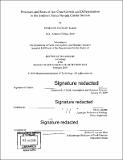Processes and rates of arc crust growth and differentiation in the Southern Sierra Nevada crustal section
Author(s)
Klein, Benjamin Zachary.
Download1102054618-MIT.pdf (27.89Mb)
Other Contributors
Massachusetts Institute of Technology. Department of Earth, Atmospheric, and Planetary Sciences.
Advisor
Oliver Jagoutz.
Terms of use
Metadata
Show full item recordAbstract
This thesis presents a multidisciplinary investigation of the processes and timescales for the construction of arc crust, with a focus on the exposed crustal section in the southernmost Sierra Nevada Batholith, California. This section exposes plutons that were emplaced at pressures ranging from 3-10 kbars, as well as metamorphic wall rocks. Chapters 1 and 2 represent focused studies of the Bear Valley Intrusive Suite (BVIS), the dominant igneous component of the crustal section. Chapter 1 presents new magmatic structural data and whole rock geochemical data that highlight a discontinuity in the BVIS between a lower crust dominated by originally shallowly lying mafic cumulates and an upper crust dominated by steeply oriented felsic intrusives. These observations are used to constrain the thermal state of the arc during the emplacement of the BVIS. Chapter 2 is a high-precision CA-ID-TIMS U/Pb zircon geochronology study of the BVIS. This study shows that the entire BVIS was emplaced within 1.1 million years, and thus represents the highest documented (intrusive) subduction zone magmatic flux. Chapter 3 focuses on the contribution of the metamorphic wall-rocks to the observed crustal section. Using detrital zircon geochronology, I argue that these wall-rocks preserve an inverted stratigraphy that is most easily explained if these sediments were first subducted and subsequently returned as relaminated material, which would make these materials the first in situ example of relaminated sediments. Chapters 4 and 5 present broader studies of subduction zone processes in space and time. In Chapter 4, I present a study based on a global compilation of modern arc lavas. This study develops new proxies that use distinctive major element trends produced by fractionating magmas to qualitatively constrain the hydration state and initial fractionation pressure of differentiating magmas, and finds that magmas in continental arcs typically evolve at wetter and higher-pressure conditions compared to island arcs. Finally, Chapter 5 investigates the dynamics of subducted slabs through Earth's history and finds that, based on anticipated higher mantle temperatures and concomitant thicker, more mafic oceanic crust, subducted slabs in the Archean are unlikely to have stagnated within or immediately below the mantle transition zone.
Description
Thesis: Ph. D. in Geology, Massachusetts Institute of Technology, Department of Earth, Atmospheric, and Planetary Sciences, 2019 Cataloged from PDF version of thesis. Includes bibliographical references.
Date issued
2019Department
Massachusetts Institute of Technology. Department of Earth, Atmospheric, and Planetary SciencesPublisher
Massachusetts Institute of Technology
Keywords
Earth, Atmospheric, and Planetary Sciences.